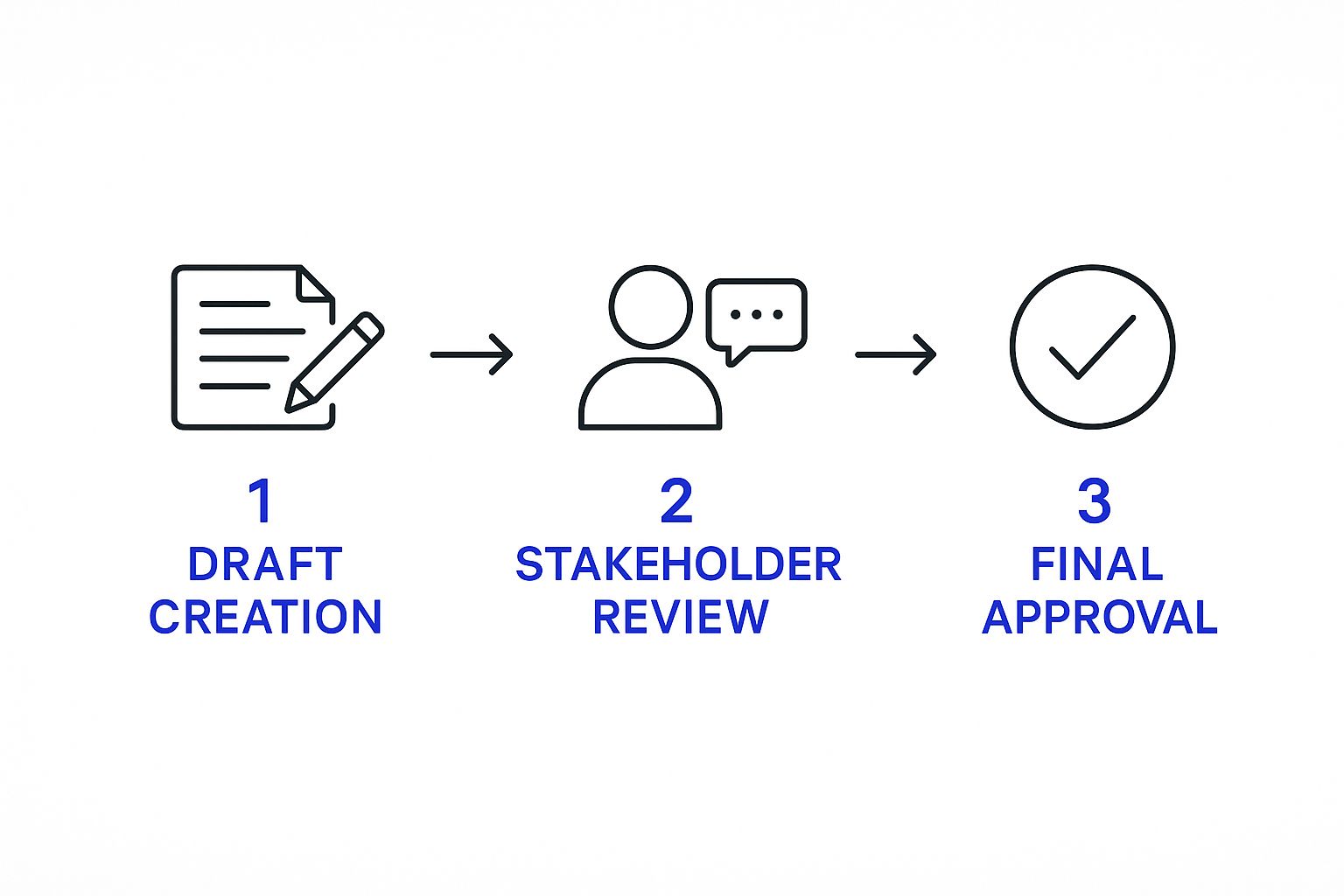Let's be honest. A broken content approval process is more than just a minor headache; it’s a silent killer of both productivity and your team's creative spark. When feedback flies in from every direction and nobody knows who has the final say, you get trapped. It’s a frustrating cycle of endless revisions, watered-down messages, and blown deadlines that turns collaboration into a bottleneck.
Why Your Content Approval Process Is Broken
Does the phrase "too many cooks in the kitchen" hit a little too close to home when you think about your content reviews? If so, you've got a problem. A disorganized approval process often starts with good intentions—everyone wants to help!—but it quickly spirals into a mess that drains productivity. The real issue isn't a lack of effort; it's a complete lack of structure.
When you have multiple reviewers with overlapping authority all chiming in, you’re guaranteed to get conflicting feedback. The marketing manager wants a punchier, more aggressive tone. At the same time, the product lead insists you add more technical jargon. This tug-of-war forces your content creators to constantly pivot, trying to satisfy everyone and ultimately pleasing no one. The final product? Usually something weak, generic, and completely forgettable.
The Consequences of a Chaotic Workflow
This "review-by-committee" approach creates some serious downstream problems. It’s not just a feeling; the data backs it up. A disorganized content approval process is a massive bottleneck for businesses, with a staggering 52% of companies admitting they regularly miss deadlines because of these very delays. Think about that. Even a short piece of content can take over eight days and cycle through three rounds of revisions before it finally gets the green light. We've seen it time and time again.
The damage goes far beyond just missing a deadline:
- Team Frustration and Burnout: Nothing crushes morale faster than endless, conflicting revisions. It wears down even your most dedicated creators and leads to total disengagement.
- Diluted Messaging: When content is edited by a committee, it loses its edge. The sharp, focused voice you were aiming for gets sanded down until it fails to connect with anyone.
- Wasted Resources: Every single unnecessary revision cycle eats up precious time and budget—resources that could have been spent creating the next great piece of content.
The biggest problem we see isn't the tools people are using. It’s the total absence of a structured workflow with clearly defined roles. When everyone is in charge, no one is truly accountable for the final decision, and that’s a recipe for endless back-and-forth.
Diagnosing Your Current Content Workflow Issues
So, how do you know if your process is truly broken? It usually leaves a trail of clues. This table breaks down some of the most common red flags we see, what’s really causing them, and the damage they do.
| Common Symptom | Underlying Cause | Business Impact |
|---|---|---|
| Feedback scattered across email, Slack, and docs | No single source of truth for communication | Wasted time hunting for comments; critical feedback gets lost. |
| Constantly missed deadlines | Too many reviewers or no clear final approver | Delays campaign launches, creates a reactive marketing culture. |
| Watered-down, generic final content | "Design by committee" trying to please everyone | Low engagement, poor brand recall, and weak ROI. |
| High team frustration and creator burnout | Endless revision cycles and conflicting feedback | Low morale, high turnover in creative roles, loss of talent. |
| Marketing and other departments are misaligned | Lack of a shared, transparent approval process | Inconsistent brand messaging across different channels. |
Recognizing these symptoms is the first step toward building a better system. If you find yourself juggling feedback across countless email threads and Slack channels, or constantly pushing deadlines to get that one last sign-off, it’s a clear signal your approach isn't working. This complexity only gets worse when you have to manage multiple social media accounts, where getting timely approvals is absolutely critical for staying relevant.
The goal here isn't just to patch a few holes. It's to build an accountable, efficient system that puts an end to these bottlenecks for good.
Designing Your Ideal Approval Workflow
Moving from a chaotic, "anything goes" approach to a structured content approval process is a total game-changer. But building this system isn't just about adding a bunch of rules; it's about designing a workflow that actually helps your team create better work, faster.
The first move? Map out every single stage your content needs to go through before it sees the light of day.
Don't just think in terms of "draft" and "final." A truly solid workflow accounts for every critical touchpoint. For most of us in marketing, that means starting with the initial draft, getting it reviewed by a subject matter expert (SME) for accuracy, passing it through a brand and messaging check, and sometimes even a legal review if you're in a regulated industry.
This simple flow diagram shows the basic journey from creation to sign-off.

When you visualize the workflow like this, it suddenly becomes crystal clear how content should move through the pipeline, making sure no step gets missed. It’s all about creating a methodical, forward-moving process that kills the endless back-and-forth between stages.
Defining Clear Roles and Responsibilities
Once your stages are mapped out, you need to assign clear roles. I’ve seen firsthand how ambiguity here creates massive bottlenecks. Who writes the piece? Who fact-checks it? And, maybe most importantly, who has the final say to hit "publish"? Without these roles defined, you either get too many cooks in the kitchen giving conflicting feedback or nobody stepping up to take ownership.
This is where a Responsibility Assignment Matrix, better known as a RACI chart, becomes your best friend. A RACI chart clearly defines who is:
- Responsible: The person actually doing the work (like the content writer).
- Accountable: The one person who owns the final decision (like the content marketing manager). There should only ever be one "A" for any given task.
- Consulted: The experts you need input from (think product managers or legal counsel).
- Informed: People who just need a heads-up on progress but don't have a say (like the sales team or an executive).
A well-defined RACI chart is the single most effective tool for eliminating confusion. It transforms a vague process into an accountable system where everyone knows their exact contribution and authority level.
Adapting Workflows for Different Content Types
Let’s be real: your workflow for a 2,000-word blog post shouldn't be the same as the one for a quick tweet. A social media update might just need a quick once-over from the social media manager, while a technical whitepaper will demand rigorous reviews from engineering, legal, and marketing leaders.
The trick is to create slightly different workflow templates for each major content category you produce. For instance:
Blog Post Workflow
- Draft (Writer)
- Editorial Review (Editor)
- SME Review (Product Team)
- Final Approval (Content Manager)
Social Media Campaign Workflow
- Copy & Visuals (Social Media Specialist)
- Brand Review (Marketing Manager)
- Final Approval (Social Media Manager)
Creating these tailored paths means you’re applying the right amount of scrutiny where it's needed without slowing down your faster-moving content. This adaptability is absolutely key to keeping both quality and agility at the core of your content operations.
Putting Your Process Into Practice With the Right Tools

Let's be real. A perfectly designed workflow on paper is useless if it doesn't translate to your team's day-to-day reality. Without the right tech to back it up, even the most brilliant content approval process will crumble back into the familiar chaos of scattered emails and blown deadlines. The real work starts when you turn that theoretical flow into a living, breathing system that does the heavy lifting.
This is all about finding a platform that can transform your workflow diagram into a set of automated actions. Imagine never having to manually chase down a stakeholder for a review again because the system sends them a notification automatically. That simple change alone can slash your review cycle time.
Build Your Workflow in a Central Hub
First things first: you need a single source of truth. It's time to say goodbye to passing around Word docs or digging through endless comment threads to find that one piece of feedback. A dedicated hub like PostSyncer lets you build your custom approval stages right inside your content calendar.
This immediately brings a level of clarity that’s impossible with manual methods. Anyone on the team can see exactly where a piece of content is at any given time—whether it's "Drafting," "SME Review," or "Awaiting Final Approval." For example, when a writer flips a blog post's status from "Drafting" to "SME Review," the system instantly pings the designated expert to let them know it’s their turn.
This isn't just a "nice-to-have" anymore. With 82% of companies now deep into content marketing, it’s no surprise that workflow snags are a top complaint for 41% of marketers. The pressure is on, especially when you learn that 83% of marketers believe quality is far more important than quantity. That puts a huge strain on the review process to be both meticulous and fast.
Key Features to Look For
When you're shopping for a tool, don't get distracted by shiny objects. Focus on the features that actually enforce accountability and transparency. These are the nuts and bolts that keep your content engine running smoothly.
- Version Control: This is non-negotiable. It completely kills the confusion over which draft is the current one and gives you a clean history of every change made.
- Side-by-Side Comparisons: An absolute lifesaver. This feature lets reviewers see exactly what’s different between versions, so they can stop re-reading old text and focus their feedback where it counts.
- Auditable Trails: You need a complete, timestamped log of every action. Who requested a change? Who approved a draft? When did it happen? This creates total accountability.
A great tool doesn't just hold your content; it actively orchestrates the entire flow of communication and approvals. It becomes the unbiased referee for the process you designed, making sure no step gets skipped and no deadline is ignored.
Plenty of teams also find huge value in tools that plug into their existing project management software. For instance, you can automate approval workflows in Jira to link your content tasks directly to the company's broader project timelines.
By investing in the right platform, you're not just buying software—you're giving your team the scaffolding it needs to succeed. It transforms your content approval process from a frustrating bottleneck into a well-oiled machine. And if you're dealing with a high volume of social content, checking out the best social media automation tools can cut out even more manual work and guarantee every post gets the green light on time.
Optimizing Your Workflow for Peak Performance
 Getting your new content approval process up and running is a huge accomplishment, but it's not the finish line. Far from it. This is where the real work—and the real payoff—begins. Continuous improvement is how you turn a good process into a truly great one that evolves with your team.
Getting your new content approval process up and running is a huge accomplishment, but it's not the finish line. Far from it. This is where the real work—and the real payoff—begins. Continuous improvement is how you turn a good process into a truly great one that evolves with your team.
The optimization phase is all about moving from guesswork to data. You need to stop wondering where the holdups are and start measuring. By tracking the right key performance indicators (KPIs), you can pinpoint exactly where friction is slowing you down. Are drafts getting stuck in legal review for two weeks? Do certain writers consistently need more revision cycles? Data gives you the hard answers.
When you're juggling a lot, understanding the nuances of managing multiple projects simultaneously can make a world of difference in keeping your content engine running smoothly.
Finding Bottlenecks with the Right Metrics
To get started, you have to know what to track. This isn't about micromanaging your team; it's about spotting the systemic issues holding everyone back.
Here are the metrics I always keep an eye on:
- Average Approval Time: This is your north star. It’s the total time from the first draft submission to the final sign-off.
- Time Spent in Each Stage: Break down the total approval time to see where content lingers. This quickly exposes specific bottlenecks, like an overloaded subject matter expert or a slow brand review.
- Number of Revision Cycles: How many times does a piece get sent back for edits? A high number often means your creative brief is weak or reviewers aren't giving clear feedback.
- Stakeholder Adherence to Deadlines: Track how often reviewers hit their deadlines. If one person or department is consistently late, it’s time for a conversation or a process tweak.
Don't just collect data—act on it. If you see the approval time for blog posts is double that of social media updates, dig in. Is the process too heavy for that content type? Use these insights to make targeted, effective changes.
This data-driven approach is non-negotiable. With 83% of marketers agreeing that quality trumps quantity, an efficient process ensures high standards without killing your speed. And when about 42% of leadership teams are only "mostly" bought into content marketing, a clunky approval workflow can completely undermine their confidence. A smooth process is directly tied to business results.
To really dial in your workflow, you need a clear view of what success looks like. The table below breaks down the most important metrics for evaluating and improving your content approval process.
Key Metrics for Workflow Optimization
| Metric | What It Measures | Why It Matters |
|---|---|---|
| Average Turnaround Time | The total time from content submission to final approval. | Your core efficiency metric. A shorter time means faster content delivery. |
| Time-in-Stage | How long content spends at each specific step (e.g., editing, legal). | Pinpoints exact bottlenecks in your workflow that need attention. |
| Revision Cycles Per Piece | The average number of times content is sent back for edits. | High numbers can indicate unclear briefs or ineffective feedback loops. |
| On-Time Completion Rate | The percentage of content that moves through the workflow on schedule. | Measures the overall predictability and reliability of your process. |
| Stakeholder Response Time | How quickly reviewers provide feedback or approval. | Identifies individuals or departments that may be resource-constrained. |
Tracking these KPIs gives you a powerful diagnostic tool. You can stop guessing where the problems are and start making data-backed decisions to refine your system.
Don't Forget the Human Element: Gathering Feedback
Numbers tell you what is happening, but your team can tell you why. That's why quantitative data is only half the story.
Schedule regular, informal check-ins with your writers, editors, and reviewers. This isn’t a formal performance review; it’s a casual chat to see what’s working and what’s not.
Ask them open-ended questions like:
- "What's the most frustrating part of this process for you?"
- "Are the tools we're using actually helping, or just getting in the way?"
- "Do you feel like you have everything you need to give clear, actionable feedback?"
This creates a powerful feedback loop. You might find out a bottleneck isn't a person, but a confusing software interface. Or maybe the creative brief template is missing a key section. These are the kinds of insights you’ll never get from a dashboard. By combining hard data with human experience, you can fine-tune your process into a truly high-performing system.
Proven Tips for a Smoother Review Cycle

Even the slickest content approval process can hit a wall because of simple human friction. I've seen it a hundred times. A workflow is only as strong as the collaboration happening within it. The real secret to a faster, less frustrating review cycle isn't just about the tools you use; it’s about how your team communicates, gives feedback, and handles revisions.
It all boils down to building a culture of efficient, respectful teamwork where everyone knows their part. The aim is to shift from a painful back-and-forth into a genuine, constructive partnership.
For Reviewers: Give Feedback That Actually Helps
Let’s be honest: vague feedback is a productivity killer. Notes like "this needs more punch" or "I just don't like this" are completely useless because they give the creator nothing to act on. To make a real difference, reviewers have to provide feedback that is clear, constructive, and consolidated.
Instead of throwing out subjective opinions, connect your feedback directly to the project's goals. For instance, rather than saying a headline is "boring," try something like, "This headline doesn't hit our target keyword or address the user's pain point we outlined in the brief." See the difference?
Here are a few ways to level up your feedback game:
- Be Specific and Suggest Alternatives: Don't just flag a problem. Offer a potential solution or a new direction to explore.
- Consolidate Your Notes: Please, stop sending feedback in drips and drabs. Gather all your thoughts and deliver them in one organized round to avoid confusion and conflicting requests.
- Reference the Brief: Frame every piece of feedback around the goals you all agreed on. This keeps everyone aligned and makes sure revisions are strategic, not just based on someone's personal taste.
For Creators: Proactively Manage the Feedback Process
As a creator, getting a document back covered in red can be disheartening. But your job doesn't stop once you hit "submit" on that first draft. You need to proactively manage the feedback you get to keep the project moving and avoid those endless revision cycles.
When feedback lands in your inbox, don't just dive in and start making changes. Take a breath. Organize the requests, figure out which ones will have the biggest impact, and don't be afraid to ask for clarification if something isn't clear.
Remember, you are the driver of this content. It's on you to gather all the feedback, spot any conflicting notes from different stakeholders, and take them back to the final decision-maker. This is how you stop yourself from getting caught in a crossfire of opinions.
Clearly communicating the changes you've made is just as vital. When you send back a revised draft, include a quick summary of the key updates. This simple step shows you've listened and helps the reviewer zero in on the new stuff, which can seriously speed up that final approval. You can also learn how to measure social media success to get a better handle on what content is actually working, which can make future briefs even sharper.
The Power of a Comprehensive Creative Brief
So many revision headaches don't come from bad writing—they come from a bad start. A flimsy or rushed creative brief is the single biggest cause of unnecessary edits because it forces everyone to guess what the goals are.
Think of your brief as your first line of defense against scope creep and subjective feedback. A rock-solid brief should clearly define:
- The Primary Goal: What, exactly, is this piece of content supposed to do?
- The Target Audience: Who are we talking to? What do they care about?
- Key Message and Tone of Voice: What’s the one thing we want them to remember, and how should we sound when we say it?
- Mandatory Inclusions: Are there specific stats, quotes, or calls-to-action that absolutely must be in there?
Getting everyone to agree on these core elements before a single word is written solves most potential problems right out of the gate. This one document can transform your entire content process from a chaotic guessing game into a focused, efficient machine.
Your Content Approval Process Questions, Answered
Switching to a real, structured content approval process is a big step. It’s one thing to sketch out a workflow on a whiteboard, but it's a whole other challenge to get your team to actually use it. Let's tackle some of the most common questions and roadblocks we see when teams make this move.
How Do You Get Buy-In From Resistant Stakeholders?
Getting everyone on board is often the biggest hurdle. The secret isn't just showing them what you're changing, but proving why it matters. Forget generic promises of "efficiency"—show them the data.
Pull up the numbers. How much time did you waste last month on chaotic email threads? How many deadlines slipped through the cracks last quarter because feedback was a mess? When you can point to specific pain points, the conversation changes.
Frame the new process as a solution that makes their jobs easier. This isn't about adding red tape; it's about making their feedback count and getting incredible content published faster. A great way to prove this is with a small pilot project. Let a receptive team try it out. When other departments see the quick wins and smoother process, they’ll want in.
What Is the Ideal Number of Reviewers?
There's no magic number here. The guiding principle I always follow is "as few as possible, but as many as necessary." Your main goal is to sidestep that classic "death by committee" scenario where you have too many cooks in the kitchen, leading to contradictory feedback and total gridlock.
A solid approach is to assign one key decision-maker for each critical review stage. For instance:
- One person from marketing signs off on brand voice.
- A subject matter expert gives the final word on technical accuracy.
- Someone from legal provides the compliance check.
The most critical piece of this puzzle is having a single, accountable approver who has the final say. Others can offer input and suggestions, but one person needs to be empowered to give the green light. That's what stops endless debate and keeps things moving.
How Should We Handle Urgent Content That Needs to Skip the Line?
Let's be realistic—even the most buttoned-up workflow will have exceptions. An urgent press release or a time-sensitive social media post will inevitably pop up. The key is to plan for these exceptions so they don't turn into a chaotic free-for-all.
Don't improvise. Create a clear "fast-track" protocol before you need it. Designate a specific person (or a very small group) who has the authority to push urgent content through.
This expedited process might skip a few steps, but it should never bypass non-negotiables like a final legal review. And one last thing: track every time this emergency lane is used. If it starts happening all the time, that's a huge red flag that your standard workflow is too sluggish and needs a tune-up.
Ready to stop the email chaos and build a content approval process that actually works? With PostSyncer, you can create custom approval stages, automate notifications, and keep all your feedback in one central hub. Start your free 7-day trial of PostSyncer today and see how easy it is to get your content approved on time, every time.















